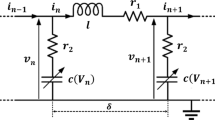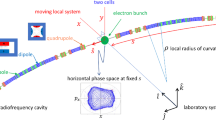Abstract
Coupled-mode theory is employed to describe the nonlinear behaviour of a distributed feedback grating, including intensity-dependent terms resulting from the periodic variations in the nonlinearity. The improved coupled-mode analysis leads to modified values for the on and off-switching intensities, as demonstrated numerically.
Similar content being viewed by others
References
M. Okuda, M. Toyota andK. Onaka,Optics Commun. 19 (1976) 138.
M. Okuda andK. Onaka,Japan J. Appl. Phys. 16 (1977) 769.
H. G. Winful, J. H. Marburger andE. Garmire,Appl. Phys. Lett. 35 (1979) 379.
H. G. Winful andG. D. Cooperman,Appl. Phys. Lett. 40 (1982) 298.
A. Mecozzi, S. Trillo andS. Wabnitz,Optics Lett. 12 (1987) 1008.
C. T. Seaton, G. I. Stegeman andH. G. Winful,Opt. Engng. 24 (1985) 593.
A. Yariv andP. Yeh, ‘Optical waves in crystals’, (Wiley, New York, 1984) pp. 429–36.
Author information
Authors and Affiliations
Additional information
On leave from Dpto. Tecnologia Fotónica, Universidad Politécnica de Madrid, Ciudad Universitaria, 28040 Madrid, Spain.
Rights and permissions
About this article
Cite this article
Fraile-Peláez, F.J., Assanto, G. Improved coupled-mode analysis of nonlinear distributed feedback structures. Opt Quant Electron 23, 633–637 (1991). https://doi.org/10.1007/BF00620089
Received:
Revised:
Accepted:
Issue Date:
DOI: https://doi.org/10.1007/BF00620089




